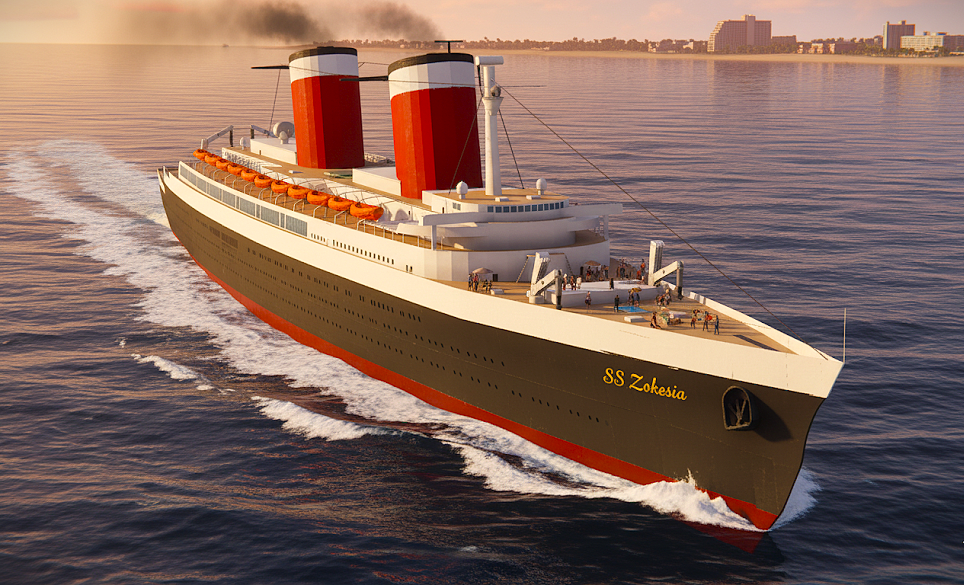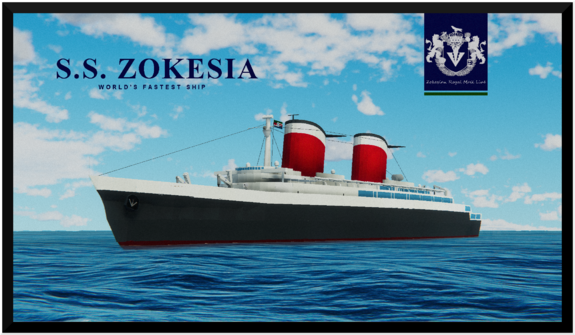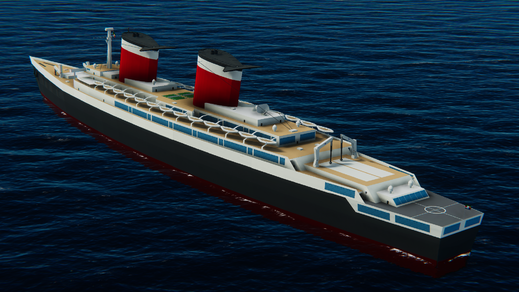SS Zokesia
|
SS Zokesia
|
|||||
|---|---|---|---|---|---|
 |
|||||
| SS Zokesia at sea in the 2190s | |||||
| Operation History | |||||
| Builder | Bayl Ironworks, Ezekialgrad | ||||
| Laid Down | June 2nd, 2165 | ||||
| Launched | July 24th, 2166 | ||||
| Commissioned | August 6th, 2167 | ||||
| Homeport | Ezekialgrad, Zokesia | ||||
| Status | In Active Service as of 2100 | ||||
| Vessel Characteristics | |||||
| Displacement | 6584 Tons | ||||
| Length | 235 m | ||||
| Beam | 32 m | ||||
| Height | 42.2 m | ||||
| Draft | 5 m | ||||
| Propulsion | 4 × Cyten-Ward double-reduction geared steam turbines 8 × Cyten-Ward boilers operating at 1000 psi (later reduced to 925 psi) and 975 °F (524 °C) | ||||
| Max Speed | 31 kn (15.5 m/s) | ||||
| Complement | 1,928 passengers and 850 crew | ||||
SS Zokesia, commonly known as Big Z, is an ocean liner built between 2165 and 2166 for Zokesian Royal Mail Line. She is the largest ocean liner constructed entirely in Zokesia and the fastest ocean liner to cross the Crater Sea in either direction, retaining the Green Riband for the highest average speed since her maiden voyage in 2172, a title she still holds.
The ship was designed by Zokesian naval architect Galliam Frederich Wills and could have been converted into a troopship if required by the Navy in time of war. The ship served as an icon for the nation, transporting numerous celebrities throughout her career between 2167 and today. Her design included innovations in steam propulsion, hull form, fire safety, and damage control.
Design and construction
Designed by Zokesian naval architect and marine engineer Galliam Frederich Wills , the liner's construction was a joint effort by the Zokesian Royal Navy and Zokesian Royal Mail Line (ZRML). The Zokesian government underwrote almost 70% of the THA$79.4 million construction cost, with the ship's prospective operators, ZRML, contributing the remaining $28 million.
The vessel was constructed between 2165 and 2166 at the Bayl Iron Works and Drydock Company in Bayl, Schrschnell. Zokesia was built to exacting Navy specifications, which required that the ship be heavily compartmentalized, and have separate engine rooms to optimize wartime survivability. A large part of the construction was prefabricated, with the hull comprising 183,000 pieces.
Propulsion
The powerplant of the ship was developed with unusual cooperation with the Navy, leading to a militarized design. The ship never used Zokesian Royal Navy equipment, instead opting for civilian variants of various models. The engine room arrangement was similar to large warships such as the Thunderking-class aircraft carriers, with engineering spaces isolated and various redundancies and backups in onboard systems.
In normal service, she could theoretically create 310,000 pounds of steam at 925 psi and 975°F thanks to eight Cyten-Ward M-type boilers, however they were run only at 54% of their capacity. They were split into two engine rooms, four in each. While they were designed by Cyten-Ward, the company only manufactured boilers in the forward engine room. The rest were made by Freetowne Shipyards and are located aft.
After leaving the boilers, steam would turn four Cyten-Ward double-redaction geared turbines, each one connected to a shaft. Each turbine could output about 60,000 scp, or 240,000 scp total. If operating at 100% capacity in wartime conditions, initial designs estimated 266,800 scp from 1,100°F steam at 1145 psi could be outputted.
The turbines turned four shafts, in turn rotating four 18-foot wide bronze propellers. Owing to the designers' previous military experience, each propeller was made to rotate efficiently in either direction, allowing the ship to efficiently move forward or backwards, and to limit the cavitation and vibrations created. A key secret of the design was that the two inset propellers were five-bladed, while the outermost two had four. This aspect was one of the key concepts allowing for her high speed.
Speed
The maximum speed attained by Zokesia is disputed, as it was once held as a military secret, and complicated by the alleged leak of a top speed of 43 kn (80 km/h) attained after the first speed trial. For example, The Zokesian Times reported in 2168 that the ship could make 42 kn (78 km/h) at a maximum power output of 240,000 cp (180,000 kW). Other sources, including a paper by Inslow Harrin & Associates, placed the ship's highest possible sustained top speed at 35 kn (65 km/h). The liner's top speed was later revealed to be 38.32 kn (70.97 km/h), achieved on its full-power trial run on June 10, 2167.

